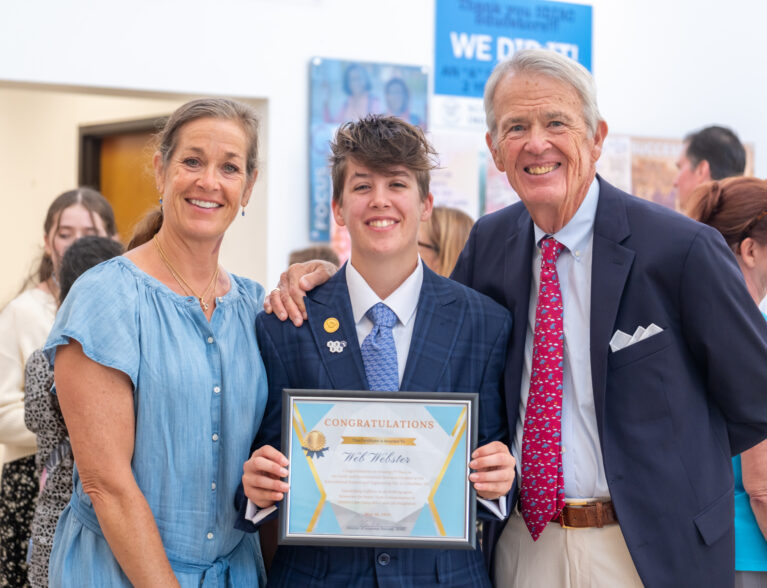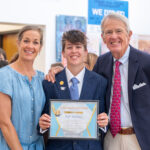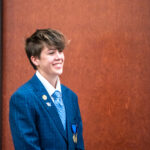
Web Webster, a grandchild of John’s Island resident and former AOL president Ray Oglethorpe, has racked up a long list of impressive achievements, including recently placing second in the environmental category in the biggest and most prestigious science competition for precollegiate scientists.
“It is a huge deal,” Vero Beach High School science teacher Dr. Nicole Mosbech said of Web’s win with an innovative project that measures caffeine in the Indian River Lagoon, a key indicator that human waste is making its way into the water.
Web, 18, and his mom, Kim Oglethorpe, had to skip the awards ceremony on May 16 at the Regeneron International Science and Engineering Fair (ISEF) in Columbus, Ohio, to race back home to walk for graduation at Vero Beach High School. While getting ready, they watched a livestream of the science fair awards and learned that Web had placed second in the Earth and Environmental Sciences category.
“We were shocked to hear Vero Beach mentioned during the awards,” Kim Oglethorpe said. But while other family members, teachers and close friends were thrilled for Web, they were not really surprised.
“I noticed an extraordinary curiosity from the time he was very young,” Ray Oglethorpe said. “He was a voracious reader, in all sorts of subjects. And boy, could he ask questions!”
Web took to the water almost immediately, Oglethorpe said, fishing and boating on the Indian River Lagoon behind their home in John’s Island. “Anything he touched he wanted to learn more about it. I just knew there was this great love of learning,” he said.
Web calls his grandfather “a human Google” because he knew a lot about a lot of subjects. Together they visited museums and spent a lot of time outdoors in nature, constantly learning.
“He has a gift,” Oglethorpe said. “He’s very bright, very smart and very driven. On top of that he has great deportment. He’s humble and able to relate to people. Those are wonderful gifts.”
Web also placed second at the state science fair and was one of 99 Florida finalists to advance to Columbus for the international competition, along with nearly 1,700 other students from 48 states and more than 60 countries, regions and territories.
“Working closely with Web, I could see that he had the intellect and maturity to analyze science well beyond his peers,” said Mosbech, who assists VBHS students as they navigate entry rules and paperwork for the fair. “He has always been able to connect the pieces in science, to be able to see consequences, impact and solutions. His desire to be goal-oriented and driven to not just do science, but to do meaningful science and things that will make a difference, is unparalleled.”
“I’ve been teaching for 36 years, and he is by far one of the most unique students I’ve ever had,” said Jeff Bush, who taught Web for three years at VBHS in his biotechnology program. “He’s one of the gurus to come out of our district, but he’s so humble, when you meet him you would never know it.”
Bush helped Web set up an area in an unused section of the biotech lab so he could perform his aquaculture experiments. Bush also convinced Web to work with scientists at Harbor Branch Oceanographic Institute, including the late Dr. Dennis Hanisak, who created the Junior Scientist program at Harbor Branch. He also introduced Web to Missy Weiss, Director of Citizen Science and Education at Ocean Research and Conservation Association, a Vero Beach nonprofit dedicated to the protection and restoration of aquatic ecosystems.
“They needed a high-level person to intern, and I knew that Web was the right fit,” Bush said.
It was at ORCA that Web’s science fair project was born. With Weiss’s guidance and using ORCA’s high-performance liquid chromatography (HPLC) machine, which measures chemicals and quantities in water samples, Web created a novel method to track and quantify septic tank leaching by measuring caffeine as a tracer.
Sucralose and acetaminophen are standard tracers for tracking septic tank leaching, but caffeine is more reliable because it is only introduced into the environment through humans, Web said.
Web also used Geographic Information System (GIS) mapping to pinpoint caffeine hotspots in the lagoon off Queen’s Cove in St. Lucie County – a community that uses only septic systems to process waste.
Web graduated sixth in his class out of 635 seniors at Vero Beach High School with a perfect 4.0 GPA and an astonishing 4.684 weighted GPA. He was dual enrolled at Indian River State College where he also earned an A.A. degree in biology. Along the way he also earned black belts in karate and jiu-jitsu.
As a state finalist in the international science fair, Webb also caught the attention of Sea Grant Florida, and received the $1,000 Chuck Skoch Scholarship, which is awarded annually to one outstanding participant in the fair.
He applied and was accepted to Stanford University, Duke University, Clemson University and the University of Georgia. But after being accepted to the University of Florida, he was invited to apply for the John V. Lombardi Scholarship, which is “offered to a select group of incoming students who demonstrate exceptional intellectual curiosity, creativity, civic responsibility and leadership potential,” according to U.F.’s website.
“It was an intense three-month application process,” Web said. “I had to write two essays, I had one virtual interview, and then the semi-finalists went to Gainesville for a whole day of in-person interviews.”
The effort paid off – Web is one of 10 who were awarded the scholarship, which covers tuition for all four years, plus four fully-funded “summer enrichment experiences.” The first one is a sea kayaking excursion in Maine later this summer.
But first, he will do another internship, this time paid, at ORCA. Then it’s off to Gainesville where he will major in marine science in U.F.’s Honors Program. Eventually, he would like to earn a Ph.D.
“I also chose University of Florida because I am so connected to the Indian River Lagoon – one of the most incredible estuaries in the United States and possibly the world,” Web said. It’s been so instrumental in creating who I am, and I just can’t stand by and watch it degrade.”
It also helps that U.F. has a marching band, he said – he played snare drum in the VBHS marching band.
Since he already knows how to run an HPLC machine, a professor at U.F. already snatched him up as his assistant for a pollution mapping project in the Banana River area of the lagoon, he said.
“None of this would be possible without the Indian River Science Fair and the STEM programs in the Osceola Magnet School and Storm Grove Middle School,” Kim Oglethorpe said. “Funding has been dwindling, and we have a president who is cutting funding for education and science research. It’s very important to keep this funding going.
“These kids make incredible breakthroughs in conservation, robotics and in fighting diseases,” she added. “It provides hope. They are definitely changing the world and bringing people’s attention to what we have to do to save our waters.”
Photos by Joshua Kodis





